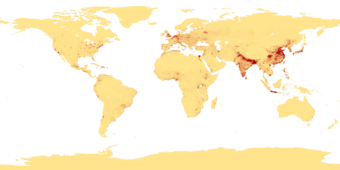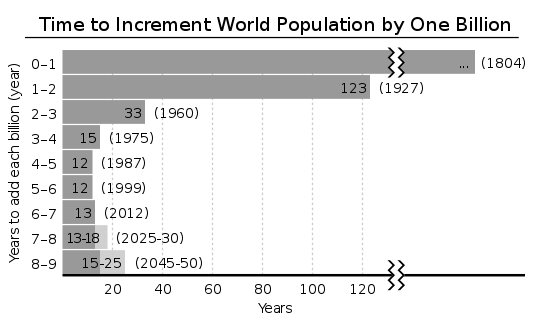Population
In biology, a population is all the organisms of the same group or species who live in a particular geographical area and are capable of interbreeding.[1][2] The area of a sexual population is the area where inter-breeding is possible between any pair within the area and more probable than cross-breeding with individuals from other areas.[3]


In sociology, population refers to a collection of humans. Demography is a social science which entails the statistical study of populations. Population, in simpler terms, is the number of people in a city or town, region, country or world; population is usually determined by a process called census (a process of collecting, analyzing, compiling and publishing data).
Population genetics (ecology)
In population genetics a sexual population is a set of organisms in which any pair of members can breed together. This means that they can regularly exchange gametes to produce normally-fertile offspring, and such a breeding group is also known therefore as a gamodeme. This also implies that all members belong to the same species.[4] If the gamodeme is very large (theoretically, approaching infinity), and all gene alleles are uniformly distributed by the gametes within it, the gamodeme is said to be panmictic. Under this state, allele (gamete) frequencies can be converted to genotype (zygote) frequencies by expanding an appropriate quadratic equation, as shown by Sir Ronald Fisher in his establishment of quantitative genetics.[5]
This seldom occurs in nature: localization of gamete exchange – through dispersal limitations, preferential mating, cataclysm, or other cause – may lead to small actual gamodemes which exchange gametes reasonably uniformly within themselves but are virtually separated from their neighboring gamodemes. However, there may be low frequencies of exchange with these neighbors. This may be viewed as the breaking up of a large sexual population (panmictic) into smaller overlapping sexual populations. This failure of panmixia leads to two important changes in overall population structure: (1) the component gamodemes vary (through gamete sampling) in their allele frequencies when compared with each other and with the theoretical panmictic original (this is known as dispersion, and its details can be estimated using expansion of an appropriate binomial equation); and (2) the level of homozygosity rises in the entire collection of gamodemes. The overall rise in homozygosity is quantified by the inbreeding coefficient (f or φ). Note that all homozygotes are increased in frequency – both the deleterious and the desirable. The mean phenotype of the gamodemes collection is lower than that of the panmictic original – which is known as inbreeding depression. It is most important to note, however, that some dispersion lines will be superior to the panmictic original, while some will be about the same, and some will be inferior. The probabilities of each can be estimated from those binomial equations. In plant and animal breeding, procedures have been developed which deliberately utilize the effects of dispersion (such as line breeding, pure-line breeding, backcrossing). It can be shown that dispersion-assisted selection leads to the greatest genetic advance (ΔG=change in the phenotypic mean), and is much more powerful than selection acting without attendant dispersion. This is so for both allogamous (random fertilization)[6] and autogamous (self-fertilization) gamodemes.[7]
In ecology, the population of a certain species in a certain area can be estimated using the Lincoln Index.
World human population
According to the United States Census Bureau the world's population was about 7.55 billion in 2019[8] and that the 7 billion number was surpassed on 12 March 2012. According to a separate estimate by the United Nations, Earth's population exceeded seven billion in October 2011, a milestone that offers unprecedented challenges and opportunities to all of humanity, according to UNFPA.[9]
According to papers published by the United States Census Bureau, the world population hit 6.5 billion on 24 February 2006. The United Nations Population Fund designated 12 October 1999 as the approximate day on which world population reached 6 billion. This was about 12 years after the world population reached 5 billion in 1987, and six years after the world population reached 5.5 billion in 1993. The population of countries such as Nigeria is not even known to the nearest million,[10] so there is a considerable margin of error in such estimates.[11]
Researcher Carl Haub calculated that a total of over 100 billion people have probably been born in the last 2000 years.[12]
Predicted growth and decline

Population growth increased significantly as the Industrial Revolution gathered pace from 1700 onwards.[13] The last 50 years have seen a yet more rapid increase in the rate of population growth[13] due to medical advances and substantial increases in agricultural productivity, particularly beginning in the 1960s,[14] made by the Green Revolution.[15] In 2017 the United Nations Population Division projected that the world's population will reach about 9.8 billion in 2050 and 11.2 billion in 2100.[16]

In the future, the world's population is expected to peak,[17] after which it will decline due to economic reasons, health concerns, land exhaustion and environmental hazards. According to one report, it is very likely that the world's population will stop growing before the end of the 21st century. Further, there is some likelihood that population will actually decline before 2100.[18][19] Population has already declined in the last decade or two in Eastern Europe, the Baltics and in the Commonwealth of Independent States.[20]
The population pattern of less-developed regions of the world in recent years has been marked by gradually declining birth rates. These followed an earlier sharp reduction in death rates.[21] This transition from high birth and death rates to low birth and death rates is often referred to as the demographic transition.[21]
Control
Human population control is the practice of altering the rate of growth of a human population. Historically, human population control has been implemented with the goal of limiting the rate of population growth. In the period from the 1950s to the 1980s, concerns about global population growth and its effects on poverty, environmental degradation, and political stability led to efforts to reduce population growth rates. While population control can involve measures that improve people's lives by giving them greater control of their reproduction, a few programs, most notably the Chinese government's one-child per family policy, have resorted to coercive measures.
In the 1970s, tension grew between population control advocates and women's health activists who advanced women's reproductive rights as part of a human rights-based approach.[22] Growing opposition to the narrow population control focus led to a significant change in population control policies in the early 1980s.[23]
See also
- Community (ecology)
- List of countries by population
- Lists of organisms by population
- Human overpopulation
- Population geography
References
- "Population". Biology Online. Retrieved 5 December 2012.
- "Definition of population (biology)". Oxford Dictionaries. Oxford University Press. Retrieved 5 December 2012.
a community of animals, plants, or humans among whose members interbreeding occurs
- Hartl, Daniel (2007). Principles of Population Genetics. Sinauer Associates. p. 45. ISBN 978-0-87893-308-2.
- Hartl, Daniel (2007). Principles of Population Genetics. Sinauer Associates. p. 95. ISBN 978-0-87893-308-2.
- Fisher, R. A. (1999). The Genetical Theory of Natural Selection. Oxford University Press. ISBN 978-0-19-850440-5.
- Gordon, Ian L. (2000). "Quantitative genetics of allogamous F2 : an origin of randomly fertilized populations". Heredity. 85: 43–52. doi:10.1046/j.1365-2540.2000.00716.x. PMID 10971690.
- Gordon, Ian L. (2001). "Quantitative genetics of autogamous F2". Hereditas. 134 (3): 255–262. doi:10.1111/j.1601-5223.2001.00255.x. PMID 11833289.
- "Population Clock". www.census.gov. Retrieved 29 January 2019.
- to a World of Seven Billion People Archived 13 January 2012 at the Wayback Machine UNFPA 12 September 2011
- "Cities in Nigeria: 2005 Population Estimates – MongaBay.com". Retrieved 1 July 2008.
- "Country Profile: Nigeria". BBC News. 24 December 2009. Retrieved 1 July 2008.
- Haub, C. 1995/2004. "How Many People Have Ever Lived on Earth?" Population Today, "Archived copy". Archived from the original on 24 April 2013. Retrieved 29 April 2013.CS1 maint: archived copy as title (link)
- As graphically illustrated by population since 10,000BC and population since 1000AD
- "The end of India's green revolution?". BBC News. 29 May 2006. Retrieved 29 November 2009.
- Food First/Institute for Food and Development Policy Archived 14 July 2009 at the Wayback Machine
- "UN Population Prospects 2017" (PDF).
- World Population Development Statistics: Forecast, United Nations, 2011.
- Lutz, Wolfgang; Sanderson, Warren; Scherbov, Sergei (2001). "The End of World Population Growth" (PDF). Nature. 412 (6846): 543–545. doi:10.1038/35087589. PMID 11484054.
- Ojovan, M.I.; Loshchinin, M.B. (2015). "Heuristic Paradoxes of S.P. Kapitza Theoretical Demography". European Researcher. 92 (3): 237–248. doi:10.13187/er.2015.92.237.
- "world demographic trends". gsociology.icaap.org. Retrieved 18 July 2019.
- "Archived copy". Archived from the original on 30 March 2009. Retrieved 7 April 2009.CS1 maint: archived copy as title (link)
- Knudsen, Lara (2006). Reproductive Rights in a Global Context. Vanderbilt University Press. pp. 2. ISBN 978-0-8265-1528-5.
reproductive rights.
- Knudsen, Lara (2006). Reproductive Rights in a Global Context. Vanderbilt University Press. pp. 4–5. ISBN 978-0-8265-1528-5.
reproductive rights.
External links
- United Nations Population Division
- CICRED homepage a platform for interaction between research centres and international organizations, such as the United Nations Population Division, UNFPA, WHO and FAO.
- Population Reference Bureau analyzes demographic data and research providing objective, accurate, and up-to-date population information in accessible formats.
- Current World Population
- NECSP HomePage
- Overpopulation
- Population World: Population of World. Retrieved 13 February 2004.
- SIEDS, Italian Society of Economics Demography and Statistics
- United Nations Economic Commission for Europe – Official Web Site
- World Population Counter, and separate regions.
- WorldPopClock.com. (French)
- Populations du monde. (French)
- OECD population data
- Understanding the World Today Reports about world and regional population trends
- Lee, Ronald Demos (2008). "Population". In David R. Henderson (ed.). Concise Encyclopedia of Economics (2nd ed.). Indianapolis: Library of Economics and Liberty. ISBN 978-0-86597-665-8. OCLC 237794267.